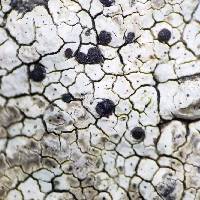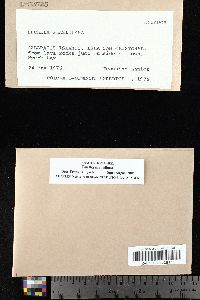
Consortium of Lichen Herbaria
- building a Global Consortium of Bryophytes and Lichens as keystones of cryptobiotic communities -
- Home
- Search
- Images
- Species Checklists
- US States: O-Z >
- US National Parks
- Central America
- South America
- US National Parks
- Southern Subpolar Region
|
|
|
|
Family: Caliciaceae
[Buellia australica Räsänen, moreBuellia glaziouana (Kremp.) Müll. Arg., Buellia glaziouana f. albinea Räsänen, Buellia glaziouana f. glaziouana (Kremp.) Müll. Arg., Buellia glaziouana var. glaziouana (Kremp.) Müll. Arg., Buellia glaziouana var. poliocheila (Vain.) Imshaug, Buellia glaziouana var. sensitiva (Zahlbr.) Imshaug, Buellia thomae (Tuck.) Imshaug comb. inval., Rinodina mamillana Tuck., Rinodina thomae Tuck.] |
Nash, T.H., Ryan, B.D., Gries, C., Bungartz, F., (eds.) 2007. Lichen Flora of the Greater Sonoran Desert Region. Vol 3. Thallus: crustose, rimose, rarely becoming rimose-areolate, thin to moderately thick, ±continuous; prothallus: distinct, delimiting the thallus as a black outline surface: usually pale greenish yellow, rarely gray (older herbarium specimens), dull or rarely ±shiny, smooth, epruinose, phenocorticate, esorediate medulla: white, lacking calcium oxalate (H2SO4-) Apothecia: mamillana-type, initially lecanorine, but soon becoming lecideine; (0.3-)0.6-0.9(-1.1) mm in diam., usually adnate to sessile, rarely remaining immersed margin: brown, blackening with maturity, thickening with maturity, inconspicuous in immature apothecia, but soon becoming distinct disc: dark brown to black, epruinose, plane, usually becoming ±convex proper exciple: first thin, indistinct but soon thickening, i.e., inner excipular hyphae distinct, hyaline but becoming pigmented with age, prosoplectenchymatous (textura angularis), distinct, not reduced, similar in structure and orientation to the, deep reddish brown hypothecium (leptoclinoides-brown, textura intricata), outer excipular hyphae short-celled, cells angular, ±swollen (textura angularis) and ±carbonized with various amounts of a brown pigment (cf. elachista-brown, HNO3-) epihymenium: brown, pigmentation continuous with the outer exciple (HNO3-) hymenium: hyaline, not inspersed with oil droplets; paraphyses: simple to moderately branched, apically swollen, with a brown pigment cap (cf. elachista-brown) asci: clavate, Bacidia-type, 8-spored ascospores: soon brown, 1-septate, oblong to ellipsoid, usually not constricted, with obtuse ends, not curved, (10.5-)12-[13.8]-15.7(-18.5) x (5.5-)6.3-[7]-7.8(-10) µm (n=60); proper septum: becoming soon but only briefly thickened during spore ontogeny (±Physconia-type); ornamentation: rugulate Pycnidia: rare, urceolate to globose, unilocular; ontogeny similar to the Umbilicaria-type conidiogenous cells: mostly terminal, rarely also intercalary (cf. conidiophore-type III) conidia: fusiform, 6-14 x 1-1.5 µm (n=20) Spot tests: K+ yellow, P- or P+ yellow, C-, KC-, CK- (spot tests sometimes weak) fluorescence: UV+ bright or pale yellow to orange iodine reaction: medulla amyloid Secondary metabolites: 4,5-dichloro-3-O-methylnorlichexanthone, 4,5-dichlorolichexanthone, 4-chlorolichexanthone, atranorin, 2'-O-methylperlatolic, divaricatic, norstictic and hypostictic, stictic, methylstictic, and cryptostictic acids, and one unknown trace substance (J. A. Elix, HPLC). Substrate and ecology: epilithic, on shaded, steep, ±vertical, siliceous rock faces (HCl-) in montane habitats World distribution: tropical and subtropical localities throughout the world (Mexico, the Caribbean, Brazil, India, southeastern USA, and South Africa) Sonoran distribution: common in southeastern Arizona, the Sierra Madre Occidental (Sonora and Chihuahua) and also in Baja California and Baja California Sur. Notes: The taxonomic position of B. mamillana is currently uncertain. Like several other species with unique characters, it cannot be assigned to any of the recently proposed segregates of the genus sensu Marbach (2000). Ontogeny and structural anatomy of the apothecia in B. mamillana are rather unusual and closely resemble the coco's-type of Pyxine, a foliose genus, with which the species thus has closer affinity than with Buellia s. str. Two other species show a similar ontogeny with a thalline exciple becoming entirely replaced by a fully developed proper exciple: Buellia dakotensis and B. fouquieriensis. However, those species are not closely related to B. mamillana. They have filiform conidia, lack xanthones and, apart from their exciple ontogeny, show no other similarities with B. mamillana. At maturity the proper exciple of B. mamillana remains ±pale throughout and is composed of thin-walled hyphae similar in orientation to the paraphyses. In contrast, the mature proper exciple of B. dakotensis and B. fouquieriensis becomes distinctly pigmented within and then more closely resembles the dispersa-type. |
|
|
|
Powered by Symbiota


































































































